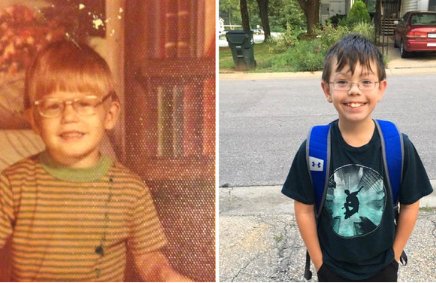The undeniable case for genetic testing
May 1, 2018
This grandfather and grandson were both diagnosed with retinitis pigmentosa as young boys. The difference in their experiences, however, is measured by more than years. Scientific advances in genetic testing and gene therapy research are transforming the diagnostic journey.

Andy Coffield (left) and his grandson Tyler Kitchengs (right) share the same inherited retinal disease.
Andy Coffield was 8 years old in 1976 when doctors diagnosed him with retinitis pigmentosa (RP). Coffield’s physician told the boy’s parents that there was nothing to be done—that the inherited retinal disease (IRD) would cause the third grader’s vision to progressively decline until he became completely blind. The boy’s parents took the only step open to them at the time: They sent their son to the state school for the blind, where he learned how to live successfully in a sighted world.
Fast forward to 2015 when Coffield’s 10-year-old grandson, Tyler, began having trouble seeing at night. With the onset of this early night blindness, Crystal Kitchengs—Tyler’s mom—heard alarm bells go off. She knew her father’s disease was hereditary. Following a litany of tests with a retinal specialist and a two-week wait for results, Kitchengs received the news she had feared for years. Her son had X-linked retinitis pigmentosa, just like her father.
Genetic testing is now a “need to have”
What happened next in Tyler’s journey, however, underscores just how much science has changed since the boy’s grandfather was diagnosed 42 years ago. “The specialist referred us for genetic testing,” says Kitchengs, “to see if there was anything that could be done to slow the progression of the disease.” To make that determination, physicians needed to know the genetic mutation responsible for Tyler’s RP, something only available through genetic testing.
Changes in science and medicine have transformed genetic testing to a “need to have” for those living with an IRD. Doctors and patients should no longer be satisfied with just a clinical diagnosis of IRDs such as retinitis pigmentosa, Leber congenital amaurosis, Stargardt, or choroideremia. Knowing the genetic mutation responsible for the disease may help patients and their doctors:
- better manage the disease
- make informed family planning decisions
- identify possible clinical studies to consider
She said that if we knew which gene was responsible for Tyler’s disease, then we could narrow down our search for clinical trials he might be eligible for.”
Genetic counseling clarifies the RP2 mutation
Kitchengs says it was their meeting with a genetic counselor that clarified the importance of testing. “She said that if we knew which gene was responsible for Tyler’s disease, then we could narrow down our search for clinical trials he might be eligible for,” remembers Kitchengs. To date, more than 2,300 gene therapy clinical trials are planned, ongoing, or have been completed for different genetic diseases, highlighting how quickly medicine and our understanding of IRDs is changing. Kitchengs wanted to be armed with as much information as she could be about Tyler’s disease in the event a medical opportunity comes their way. Genetic testing has done that for her.
Tyler’s testing resulted in a conclusive report, identifying his form of X-linked RP as associated with a mutation on the RP2 gene.1 While there currently aren’t any clinical trials for the relatively rare RP2 mutation, Tyler’s genetic counselor believes it’s only a matter of time before researchers start to address the condition.
The benefits of knowing your mutation
More than 260 genes are linked to retinal degeneration.2
Identifying the mutation responsible for your IRD helps genetic counselors, retinal specialists, and even your family doctor keep watch for medical news or clinical trials that may be relevant for you or your loved one. Understanding the basic cause of your disease streamlines and makes possible that identification process.
Genetic testing is important for another reason, as well. Kitchengs knows that eventually her son will want to share his diagnostic information with his own children. “Tyler’s RP is X-linked, so if he were to have a son—the boy wouldn’t be affected because he would get the Y gene from Tyler,” says Kitchengs, adding, “But if Tyler were to have a daughter, then the daughter would be a carrier, which means Tyler’s grandchildren could be affected.”

Tyler with his mom, Crystal, and younger brother, Evan.
Tracking a family’s retinitis pigmentosa to help research
The generational implication of inherited retinal disease is one of the driving forces behind My Retina Tracker, an online patient registry created by the Foundation Fighting Blindness (FFB). The 6,500-member database gives families like the Kitchengs a place to easily store their IRD medical information, including family history with the disease. That data is then stripped of all personally identifying details and shared with scientists in the hopes of creating greater understanding and propelling research toward medical advancements in the prevention or treatment of the conditions.
By sharing information with researchers, families like the Kitchengs are actually contributing to the science that may someday change the lives of children just like Tyler. While the family hopes and waits for a medical breakthrough or clinical trial that could provide hope for Tyler, Kitchengs takes solace in knowing which mutation caused her son’s vision loss. “At least we don’t have to wonder anymore,” says Kitchengs, “There is peace of mind in that.”
1. U.S. National Institutes of Health U.S. National Library of Medicine ClinicalTrails.gov. https://clinicaltrials.gov/ct2/results?cond=Retinitis+Pigmentosa. Accessed April 24 2018.2. RetNet: Summaries of Genes and Loci Causing Retinal Diseases. By genes and loci, diseases or graph. https://sph.uth.edu/retnet/sum-dis.htm. Published April 16 2018. Accessed April 24 2018.
Sign up to find out when we add new stories to the site.
